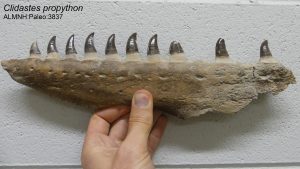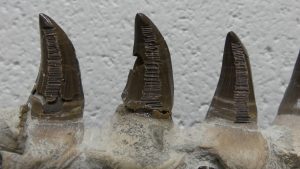This summer, an article using a well-preserved mosasaur jaw from the Alabama Museum of Natural History paleontology collection, was published in the July issue of Palaeogeography, Palaeoclimatology, Palaeoecology. The research was done by Leah Travis Taylor (master student UA Department of Geological Sciences) and colleagues including for example Becky Minzoni and Joe Lambert from the same department as well as Dana Ehret (previous curator of paleontology ALMNH) and Lynn Harrell (Geological Survey of Alabama). They used the enamel of teeth of the lower jaw of specimen ALMNH:Paleo:3837 from Aliceville, Alabama, identified as Clidastes propython, and mosasaur teeth from Kansas for geochemical analyses using oxygen isotopes. All specimens were found in rocks of Late Cretaceous age. Main conclusion? Mosasaurs migrated bi-weekly into freshwater.

